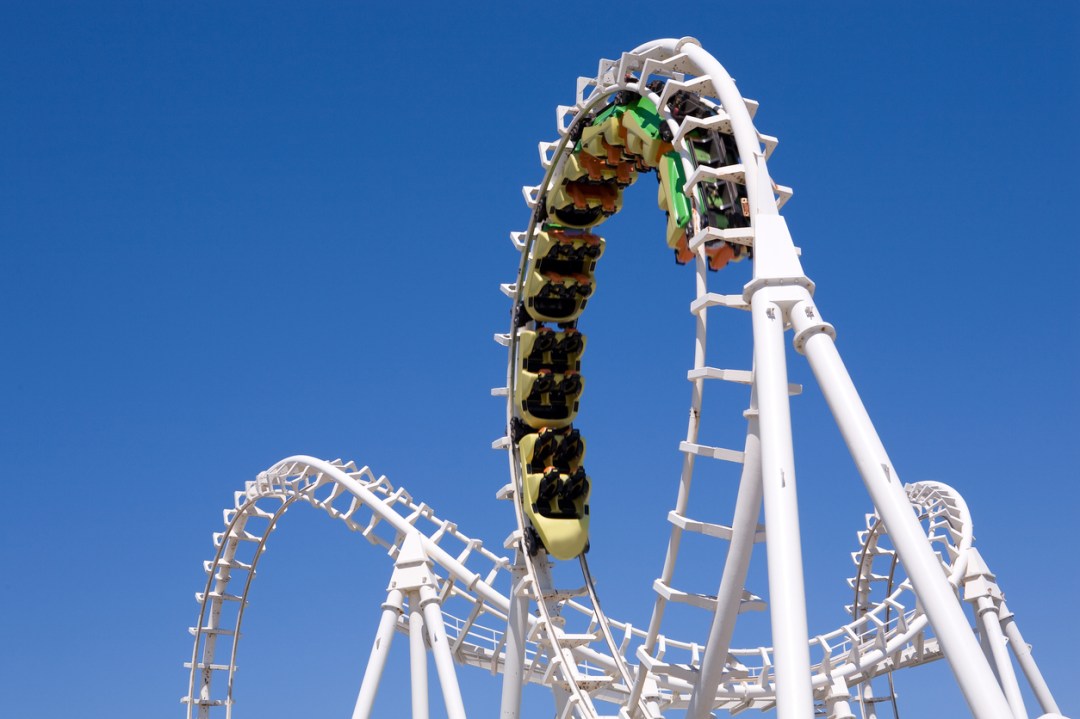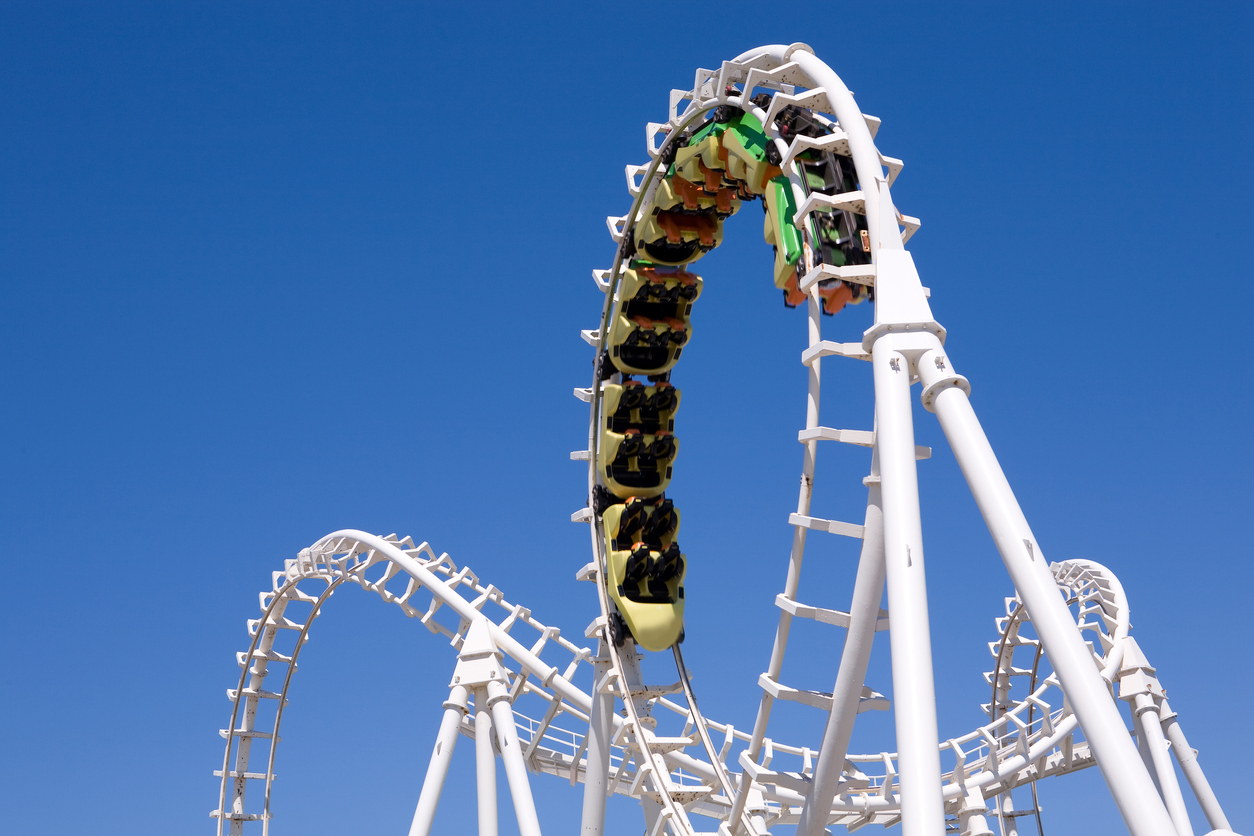My heart is racing, my breath ragged and my stomach threatening to send back the burger I ate for lunch. But as the safety harness I’m wearing is released and I lower my shaking legs to the ground there’s only one question on my mind: when can I experience it again?
My name is Antonia and I am a 44-year-old rollercoaster addict. I am hooked on rides that command queues of over an hour yet are over in seconds; that hurl me upside down, haemorrhage my bank balance and have spurious science-fiction names. In less than two years I have been to England’s twin temples of hair-raising attractions – Alton Towers in Staffordshire and Thorpe Park in Surrey – six times, battering my senses until I drive home in a stunned but satisfied stupor.
In mid-life, this is unusual, as Toby Young pointed out in The Spectator recently, writing that, after a trip to Alton Towers with his 14-year-old son, he realised he no longer enjoyed ‘the floating sensation you get in your stomach when you’re descending a steep incline and your internal organs are suddenly weightless’. He concluded: ‘At 59, I’m too old.’
But I’m just getting started. I have my children to blame, of course. In 2021 my daughter, Rosie, then ten, was invited to Alton Towers with a friend. Before that, a Brighton Pier merry-go-round was the pinnacle of her funfair exposure – but by the end of the day, her terror had turned to pride that she’d managed Oblivion, a ride that drops vertically into a hole. ‘It was brilliant,’ she whispered on her return, lest her already envious younger brother Felix overhear.
I am hooked on rides that command queues of over an hour yet are over in seconds; that hurl me upside down, haemorrhage my bank balance and have spurious science-fiction names
Too late. Felix immediately commenced a fierce campaign for a family trip. ‘Fine,’ I eventually relented, as I foraged the supermarket for two-for-one Alton Towers ticket offers on cereal boxes (tip: you rarely need to pay full price entry). ‘But I’m not going on anything scary.’
I’d never harboured a desire to go on a rollercoaster as a child, and post-pregnancy, even so much as a garden swing could set off my motion sickness. But as we approached Wicker Man, the park’s £16million newest horror-themed ride, shame at the prospect of being outdone by an eight-year-old somehow propelled me on.
As we made the agonisingly slow, creaky climb to our first drop I thought I was about to have a panic attack. Hurtling down the track with the force of a Formula 1 driver on steroids, I was convinced I was going to die. After opening my eyes and realising I’d survived, however, I felt, if not yet joy, a sense of accomplishment. Staggering off Thirteen, another rollercoaster that concludes, terrifyingly, with the carriage and track in a freefall drop, my newfound confidence eclipsed my nausea. By the end of the day, I was buzzing.
There is science behind the appeal. By causing physical signs of fear such as a pounding heart, faster breathing and the release of stress hormones adrenaline and cortisol, rollercoasters create a thrill that, on an evolutionary level, makes us feel ‘alive’, explains Professor Brendan Walker. A self-styled ‘thrill engineer’ involved in the design of both Wicker Man and Thirteen, Walker says that ‘whereas in the wild, we truly were faced with real dangers, the job of a theme park is to create the perception of danger’.
Rollercoasters also trigger the release of endorphins and serotonin, feel-good neurotransmitters other adults might seek in a glass of wine. Perhaps it is no coincidence that after I stopped drinking last year, the joy I derived from white-knuckle rides grew. As the sign to the entrance of Thorpe Park, a deceptively dreary looking site off the M25, points out: ‘No drugs or alcohol, our rides are thrilling enough!’
While the unpredictable motion of rollercoasters is thrilling for children, it’s usually more unsettling to adults who’ve long since left their days of somersaults and handstands behind. On some rides, such as Alton Tower’s Spinball Whizzer (which, as the name suggests, rotates you 360 degrees in your seat) I do feel, as Toby Young put it, that I’m being ‘tossed around like a tennis ball in a tumble dryer’.
Yet although anyone with high blood pressure or heart problems should steer clear, braving a ride can reap surprising health benefits for other adults. A study in the US National Library of Medicine found those with asthma reported more regular breathing during and after rides, while in 2016 research in the Journal of the American Osteopathic Association said the jerky motions of a rollercoaster could even dislodge kidney stones. Hearing too can apparently be improved. A 16-year-old girl who had been deaf in one ear for two months after flying found her hearing returned after going on Alton Towers’s Rita, a 60mph ride that accelerates so fast it feels more like a rocket launching than a rollercoaster. Her doctors, writing in the Indian Journal of Otolaryngology and Head & Neck Surgery, thought the change in air pressure combined with extreme gravitational force could have cleared her inner ear.
As with all drugs, tolerance builds, and so I fork out for ‘fast track’ access, tripling the cost of entrance but allowing us to jump queues and binge Nemesis, Swarm, Colossus and Galactica – names that should have no place in the forty-something vernacular.
Do I question my sanity as I strap in surrounded by riders a quarter of my age? Absolutely. But then the cogs start to whir, the adrenaline builds and I think: this sure beats Happy Valley and herbal tea for entertainment.







Comments